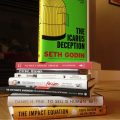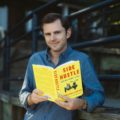How to be Everything: A guide for those who (still) don’t know what they want to be when they grow up
In a popular TEDx talk, “Why some of us don’t have one true calling”, Emilie Wapnick flips the script on conventional career advice.
Instead of suggesting that you specialize, choose a niche, or accumulate 10,000 hours of practice in a single area, she provides a practical framework for building a sustainable life around ALL of your passions.
Check out , “Why some of us don’t have one true calling,” below:
The talk turned into a new book, How To Be Everything.
“What do you want to be when you grow up?”
You probably heard this question from several adults when you were a kid. While seemingly harmless, the question has unintended consequences. It can make you feel like you need to choose one job, one passion, one thing to be about.
Guess what? You don’t.
Having a lot of different interests, projects and curiosities doesn’t make you a “jack-of-all-trades, master of none.” Your endless curiosity doesn’t mean you are broken or flaky. What you are is a multipotentialite: someone with many interests and creative pursuits. And as Emilie would say, that may actually be your biggest strength.

Available At: Amazon | Barnes & Noble | Indiebound | iBooks
Here’s an excerpt from Chapter 3: “The Components of a Happy Multipotentialite Life”:
What is the ideal career for a multipotentialite? Should we become architects, since architecture will allow us to use both sides of our brains and blend together the arts and sciences? Is project management the way to go, since it will let us focus on many things at once? Should we just reject traditional employment altogether and be our own bosses for maximum freedom and flexibility?
Unfortunately, there isn’t a single career path that is perfect for all multipotentialites. There are plenty of multipotentialites who have fulfilling professional lives as architects, project managers, and entrepreneurs, but many others for whom these careers would be a terrible fit. Although we may share an intense curiosity about numerous topics, multipotentialites are all different, and we each have our own interests, values, and priorities.
The truth, which I begrudgingly discovered while interviewing people for this book, is that happy multipotentialites can be found in any role and every industry, including some seemingly specialist ones. A pilot, for instance, might appear to be a specialist, but if you zoom out you’ll see that she is also a filmmaker and activist.
Consider the architectural drafter with a previous career in education, who will go on to open a restaurant. If this person were to be asked the question “So, what do you do?” at a party, they might answer, “I’m an architectural drafter.” Right then, you might consider them to be fairly narrowly focused, but with all the facts it’s clear that they are, in fact, a multipotentialite who moves through their interests sequentially.
Here’s the problem: if multipotentialites are able to thrive in an infinite number of professions, and what works for one person doesn’t necessarily work for the next, then where should we begin when designing our careers? To answer this question, I surveyed and interviewed hundreds of multipotentialites who self-describe as being both happy and financially comfortable. I wanted to know how they do it.
Although the interviewees and survey participants had radically different careers, they shared a few important similarities. They had all designed lives that provided them with three common elements: money, meaning, and variety—in the amounts that were right for them.







